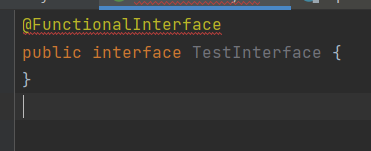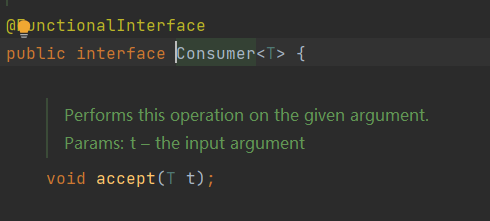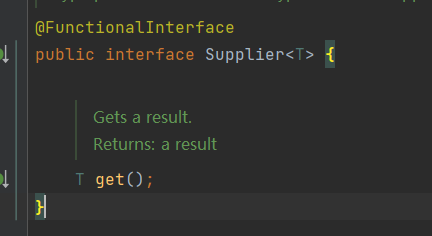1 函数式接口概述
只有一个抽象方法的接口。@FunctionInterface可以用来标注一个函数式接口,当然,这个注解并不是函数式接口的必要条件。它仅仅是用来进行标注、校验。比如一个接口标注了FunctionInterface,当它没有抽象方法,或者有多个抽象方法,都会爆红。

2 常见函数式接口
2.1 Consumer
对传入的参数进行消费。

2.2 Function
对传入的参数进行计算或转换。

2.3 Predicate
判断型接口。

2.4 Supplier
生产型接口。我们可以在方法中创建对象,并返回。

3 常用的默认方法
3.1 and
我们在使用predicate接口时,可能需要进行判断条件的拼接。
default Predicate<T> and(Predicate<? super T> other) {
Objects.requireNonNull(other);
return (t) -> test(t) && other.test(t);
}
例:打印作家中年龄小于18并且姓名长度大于1的作家。
private static void test34() {
getAuthors().stream().
filter((new Predicate<Author>() {
@Override
public boolean test(Author author) {
return author.getAge() < 18;
}
}).and(new Predicate<Author>() {
@Override
public boolean test(Author author) {
return author.getName().length() > 1;
}
}))
.forEach(author -> System.out.println(author.getName() + ": " + author.getAge()));
}
将其转换为lambda表达式并不优雅,读者可以自行尝试。
我们可以自己使用&&达到同样效果。
private static void test34() {
getAuthors().stream().
filter(author -> author.getAge() < 18 && author.getName().length() > 1)
.forEach(author -> System.out.println(author.getName() + ": " + author.getAge()));
}
您是不是认为这个and方法优点鸡肋,你错了,因为它的使用场景并非如此。举例如下。
private static void test35() {
printNum(value -> value % 2 == 0, value -> value > 5);
}
public static void printNum(IntPredicate predicate1, IntPredicate predicate2) {
int [] arr = {
1, 2, 3, 4, 5, 6, 7, 8, 9};
for (int num : arr) {
if(predicate1.and(predicate2).test(num)) {
System.out.println(num);
}
}
}
3.2 Or
例:打印年龄大于17或者小于15的作家。
private static void test36() {
getAuthors().stream()
.filter(((Predicate<Author>) author -> author.getAge() > 17).or(author -> author.getAge() < 15)
).forEach(System.out::println);
}
3.3 negate
例:打印名字不叫小米的作家。
private static void test37() {
getAuthors().stream()
.filter(((Predicate<Author>) author -> author.getName().equals("小米")).negate()).forEach(System.out::println);
}
以上几个方法一般都是在自定义函数式接口中使用。